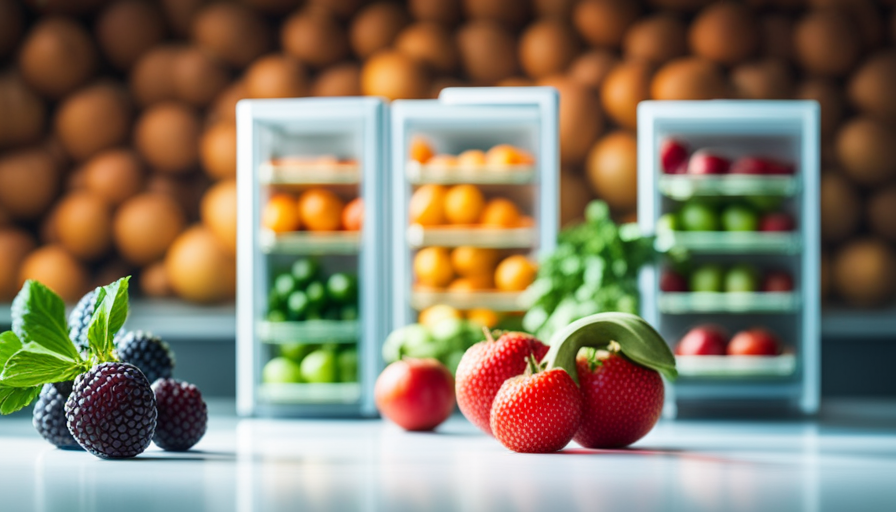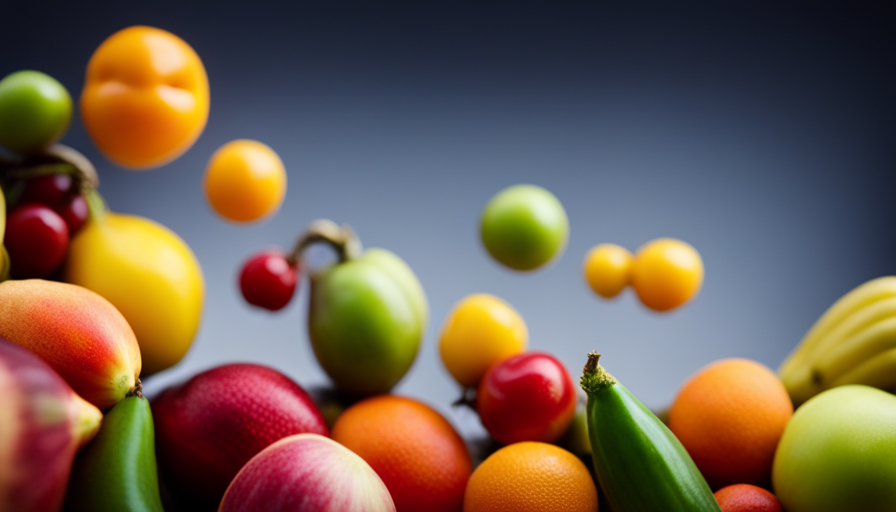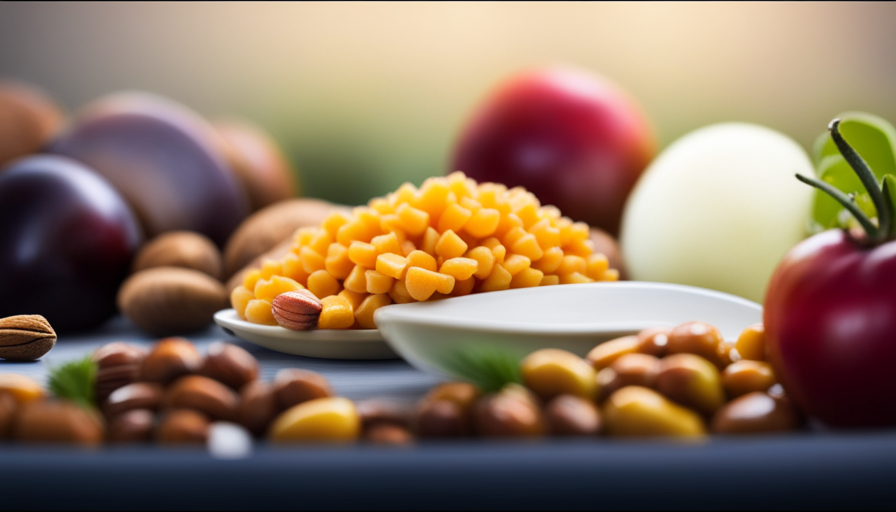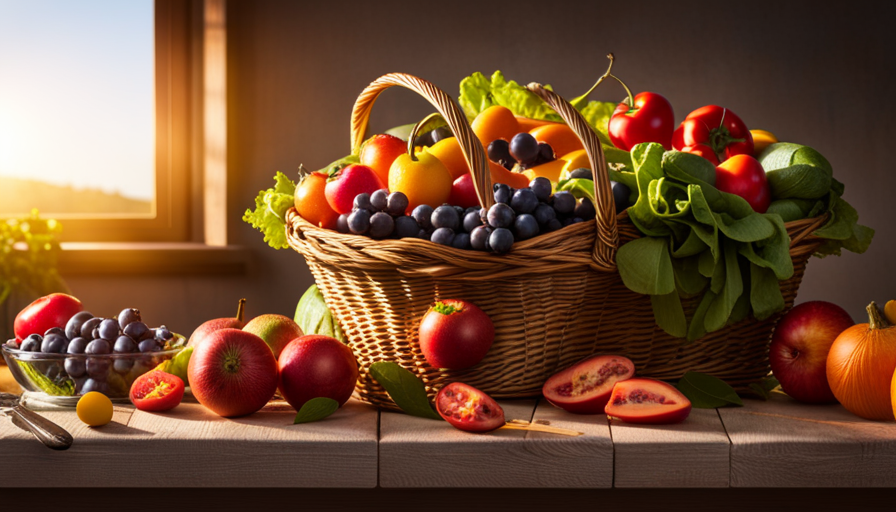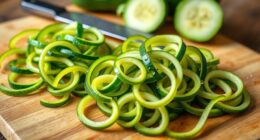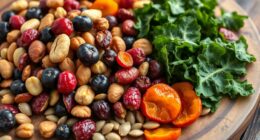Did you know that the average American household throws away around 25% of the food they purchase? This statistic is surprising, especially considering the rising cost of groceries and the increasing need to reduce food waste.
One way to combat this issue is by learning how to keep raw food fresh longer. By implementing proper storage techniques, such as temperature control and using airtight containers, you can extend the shelf life of your fruits, vegetables, and meats.
Avoiding cross-contamination, washing and drying produce, and vacuum sealing are also effective methods to maintain freshness. Additionally, utilizing natural preservatives and monitoring expiration dates can ensure that your food stays safe to consume.
Finally, rotating your stock regularly will help you use up older items before they spoil. With these strategies in place, you can minimize waste and get the most out of your groceries.
Key Takeaways
- Proper storage techniques, such as temperature control and airtight containers, can extend the shelf life of raw food.
- Avoid cross-contamination by storing different types of raw food separately and using separate cutting boards and utensils for raw meats.
- Washing and drying produce before storage, using airtight containers or freezer bags for freezing, and thawing raw food slowly in the refrigerator can help maintain freshness and reduce bacterial growth risk.
- Vacuum sealing and using natural preservatives like lemon juice, vinegar, salt, herbs, and spices can inhibit bacterial and fungal growth, improve food packaging, and extend the shelf life of raw food.
Proper Storage Techniques
To keep your raw food fresh longer, you need to know the proper storage techniques. Proper organization and the best storage methods are key to maintaining the freshness and quality of your raw food.
When it comes to storing raw food, it’s important to consider factors such as temperature, humidity, and air exposure.
To start with, proper organization is essential. Make sure to keep different types of raw food separate from each other. This will prevent cross-contamination and the spread of bacteria. Additionally, it’s crucial to store raw food in a clean and sanitized area. This will minimize the risk of contamination and help preserve the freshness.
When it comes to the best storage methods, refrigeration is your best friend. Keep your raw food in the refrigerator at a temperature below 40°F (4°C). This will slow down bacterial growth and keep your food fresh for a longer period. For specific items like meat and poultry, it’s recommended to store them on the bottom shelf of the refrigerator to avoid any potential leakage that might contaminate other food items.
Furthermore, using airtight containers or wrapping your raw food tightly in plastic wrap can help prevent moisture loss and keep the food fresh. It’s also important to label and date your raw food to ensure you use it within a safe timeframe.
By following these proper storage techniques and implementing the best storage methods, you can extend the shelf life of your raw food and enjoy fresh and safe meals for a longer period.
Temperature Control
For optimal results, make sure you’re storing your perishable items at the right temperature. Did you know that maintaining a consistently cool environment can increase the shelf life of your ingredients by up to 50%? Temperature control is crucial when it comes to keeping raw food fresh longer.
One effective method is utilizing insulated packaging, which helps maintain a stable temperature during transportation or storage. These packages are designed to provide thermal resistance, preventing heat exchange with the outside environment. The insulation keeps the contents cool, reducing the risk of bacterial growth and spoilage.
When it comes to refrigeration techniques, it’s important to set your refrigerator to the appropriate temperature. The ideal temperature range for storing raw food is between 32°F (0°C) and 40°F (4°C). This ensures that harmful bacteria cannot thrive and multiply rapidly. It’s also essential to keep raw meat, poultry, and seafood separate from other food items to avoid cross-contamination.
To maximize the freshness of your raw food, it’s recommended to store them in airtight containers or sealed plastic bags before placing them in the refrigerator. This helps maintain the quality and prevents odors from spreading to other foods. Additionally, regularly cleaning and organizing your refrigerator can help ensure proper airflow and prevent the growth of mold or bacteria.
By following these temperature control techniques and utilizing insulated packaging, you can significantly extend the shelf life of your raw food, reducing waste and ensuring the safety of your ingredients.
Using Airtight Containers
Using airtight containers helps seal in the freshness of your ingredients, ensuring that they stay in prime condition for an extended period.
When it comes to preserving raw food, a vacuum sealer is an excellent investment. This device removes air from the container, preventing the growth of bacteria and reducing oxidation, which can cause spoilage. Vacuum-sealed bags are ideal for storing meats, fruits, and vegetables. They not only keep your food fresh but also help retain its natural flavors and textures.
Another option for airtight storage is using glass jars. Glass is non-porous and doesn’t absorb odors or flavors, making it perfect for preserving the freshness of raw ingredients. Choose jars with airtight lids to create a secure seal that keeps out air and moisture. Glass jars are particularly suitable for storing items like nuts, grains, and spices, as they protect against pests and help maintain their original quality.
Using airtight containers, such as vacuum sealers and glass jars, is a reliable method to keep your raw food fresh for longer. By eliminating air and moisture, these containers prevent spoilage and maintain the quality of your ingredients. Whether you opt for a vacuum sealer or glass jars, remember to properly label and date your containers for easy organization.
Avoiding Cross-Contamination
Ensure the safety of your culinary creations by avoiding cross-contamination in your kitchen. Cross-contamination is the transfer of harmful bacteria from one food item to another, leading to potential foodborne illnesses. To prevent bacterial growth and ensure proper food handling, it’s important to follow a few key steps.
Firstly, always use separate cutting boards and utensils for raw meats and other food items. This prevents any bacteria present in the raw meat from transferring to fruits, vegetables, or cooked foods. Additionally, it’s essential to wash your hands thoroughly before and after handling raw meats to avoid spreading bacteria.
Furthermore, proper storage is crucial in preventing cross-contamination. Store raw meats, poultry, and seafood on the bottom shelf of the refrigerator to prevent any drippings from contaminating other foods. Use airtight containers or sealed plastic bags to further minimize the risk of bacteria spreading.
When preparing meals, be mindful of the order in which you handle different ingredients. Start with raw fruits and vegetables, then move on to cooked or ready-to-eat foods. This reduces the chances of any bacteria from raw meats coming into contact with other ingredients.
By following these guidelines, you can prevent cross-contamination and ensure the freshness and safety of your raw food ingredients. Proper food handling is essential in maintaining the quality of your culinary creations.
Washing and Drying Produce
To make your culinary creations even more delicious and safe, it’s time to dive into the importance of washing and drying your produce properly. Properly washing and drying your fruits and vegetables not only removes dirt and bacteria but also helps in prolonging their freshness. Here’s how to do it effectively:
-
First, start by rinsing your produce under cool, running water. This helps to remove any visible dirt and debris. Make sure to rub the surface gently to ensure thorough cleaning.
-
Next, consider using a vegetable brush to scrub hard-skinned produce such as potatoes or cucumbers. This helps to remove any stubborn dirt or wax coatings.
-
Lastly, drying your produce is equally important to prevent the growth of bacteria. Pat them dry with a clean towel or use a salad spinner to remove excess water. Remember, wet produce can spoil faster.
By following these washing and drying techniques, you can remove harmful bacteria, pesticides, and other contaminants from your produce, ensuring a safer and healthier meal. So, take the extra step in caring for your fruits and vegetables to enjoy their natural flavors and prolong their freshness.
Freezing Raw Food
By freezing raw food, you can preserve its nutrients and flavors, allowing you to enjoy the taste of fresh ingredients even in the midst of winter. Freezing is an effective method to extend the shelf life of raw food without compromising its quality.
The freezing process works by slowing down the growth of microorganisms, preventing spoilage and maintaining the nutritional value of the food.
To freeze raw food properly, start by preparing it for freezing. Wash and dry the produce thoroughly to remove any dirt or bacteria. Cut the vegetables or fruits into smaller pieces to ensure even freezing. Next, place the food in airtight containers or freezer bags, removing as much air as possible to prevent freezer burn. Label the containers with the date and contents to keep track of their freshness.
When it comes to freezing time, it depends on the type of raw food. Most fruits and vegetables can be frozen for up to 12 months, while meat and poultry can be stored for 6-12 months. However, it’s essential to check the freezing guidelines for specific foods, as some may have shorter freezing times.
When you’re ready to use the frozen raw food, it’s important to thaw it properly. The safest method is to thaw the food in the refrigerator overnight. This slow thawing process ensures that the food stays at a safe temperature, reducing the risk of bacterial growth. Avoid thawing raw food at room temperature or under running water, as these methods can promote bacterial growth.
By following these freezing and thawing guidelines, you can keep raw food fresh longer and enjoy its delicious flavors and nutrients throughout the year.
Vacuum Sealing
Why not try vacuum sealing your favorite flavors to preserve their freshness and fulfill your cravings even when they’re not in season? Vacuum sealing is a highly effective method for keeping raw food fresh longer. It works by removing air from the packaging, preventing the growth of bacteria, mold, and other harmful microorganisms that cause spoilage.
This preservation technique locks in the natural flavors, textures, and nutrients of the food, ensuring that they remain intact until you’re ready to enjoy them.
There are different types of vacuum sealers available on the market. One common type is the handheld vacuum sealer, which is compact and portable. It’s perfect for sealing smaller portions or for those who have limited storage space. Another type is the countertop vacuum sealer, which is larger and offers more features. These countertop models often come with adjustable sealing levels and can handle larger quantities of food.
The benefits of vacuum sealing are numerous. It not only extends the shelf life of raw food but also prevents freezer burn, which can negatively affect the quality of the food. Vacuum sealing also helps to save space in your refrigerator or freezer since the packages are compact and stackable. Additionally, it allows you to buy food in bulk and store it for longer periods without worrying about spoilage.
Vacuum sealing is a practical and efficient method for preserving the freshness of raw food. With different types of vacuum sealers available, you can choose the one that best suits your needs. So go ahead, give vacuum sealing a try and enjoy the benefits of longer-lasting, flavorful food.
Utilizing Natural Preservatives
Looking to add a burst of flavor to your meals while ensuring they stay delicious for longer? Try utilizing natural preservatives and discover a world of mouthwatering possibilities. When it comes to keeping raw food fresh, there are alternatives to vacuum sealing that can be just as effective. By using natural preservatives, you can improve food packaging and extend the shelf life of your favorite ingredients.
One way to utilize natural preservatives is by incorporating acidic ingredients such as lemon juice or vinegar. These can inhibit the growth of bacteria and fungi, keeping your food fresh and safe to eat. Another option is to use salt, which acts as a natural antimicrobial agent. By sprinkling a small amount of salt on your raw food, you can slow down spoilage and maintain its quality for longer.
In addition to these natural preservatives, you can also explore the use of herbs and spices. Not only do they add flavor to your meals, but many of them also possess antimicrobial properties. For example, garlic and ginger have been used for centuries to preserve food due to their natural compounds that inhibit the growth of microorganisms.
To help you understand the benefits of utilizing natural preservatives, take a look at the table below:
| Natural Preservative | Benefits |
|---|---|
| Lemon juice | Inhibits bacteria and fungi |
| Vinegar | Extends shelf life |
| Salt | Acts as a natural antimicrobial agent |
| Herbs and spices | Adds flavor and possess antimicrobial properties |
By incorporating these alternative preservatives and improving food packaging, you can keep your raw food fresher for longer. So go ahead and experiment with these natural methods to enhance the taste and longevity of your meals.
Monitoring Expiration Dates
Keep your meals at their peak of deliciousness by staying vigilant about expiration dates. Checking for signs of spoilage and using food storage labels are two essential practices for monitoring expiration dates and keeping raw food fresh for longer.
When it comes to checking for signs of spoilage, there are a few key indicators to look out for. First, pay attention to any unusual odors. If your food has a foul or off-putting smell, it’s likely gone bad. Additionally, inspect the texture and appearance of the food. Mold, discoloration, or sliminess are all signs that the food is no longer safe to consume. By regularly checking for these signs, you can catch any potential spoilage before it ruins your meal.
Another useful tool for monitoring expiration dates is food storage labels. When you bring raw food home, it’s important to label it with the date of purchase or the expiration date. This allows you to easily keep track of how long the food has been in your refrigerator or freezer. By rotating your stock and using the oldest items first, you can ensure that nothing goes to waste.
By incorporating these practices into your routine, you can extend the freshness of your raw food and enjoy delicious, safe meals for longer. Stay vigilant, use your senses to check for spoilage, and make use of food storage labels to keep track of expiration dates.
Rotating Stock Regularly
Make sure to regularly rotate your stock to ensure that you’re using the oldest items first and maximizing the freshness of your meals. Stock rotation benefits not only help maintain the quality of your raw food, but also prevent waste and save you money.
By organizing your pantry and implementing a systematic approach, you can easily keep track of expiration dates and prioritize the use of items accordingly.
To begin, create a designated area in your pantry for new purchases. This area should be easily accessible and clearly labeled. When you buy new raw food items, place them in the designated area behind the older ones. This way, you’ll always be reaching for the oldest items first, reducing the chances of any food going bad.
Next, organize your pantry by category. Group similar items together, such as fruits, vegetables, meats, and dairy products. This will make it easier to locate specific items and keep track of their expiration dates. Consider using clear storage containers or bins to further streamline the organization process.
Regularly check the expiration dates of your raw food items and make a note of them on a pantry inventory sheet. This will help you keep track of what needs to be used up first. As you prepare meals, be conscious of using the items that are closest to their expiration dates.
By implementing a stock rotation system and organizing your pantry, you can ensure that your raw food stays fresh for longer. Not only will you reduce waste, but you’ll also have peace of mind knowing that you’re making the most of your ingredients.
So, take the time to regularly rotate your stock and enjoy fresher, tastier meals.
Frequently Asked Questions
Can I use plastic wrap or aluminum foil instead of airtight containers to store raw food?
To properly store raw food without airtight containers, both plastic wrap and aluminum foil can be used. Plastic wrap is effective in preventing moisture loss and keeping the food fresh. Aluminum foil, on the other hand, provides a barrier to air and light, which helps preserve the food’s quality. However, it’s important to ensure a tight seal with both materials to minimize air exposure. Additionally, consider using double layers or wrapping the food tightly to enhance preservation.
Are there any natural preservatives that can be used to keep raw food fresh longer?
To keep raw food fresh longer, consider using natural preservatives like vinegar, lemon juice, or salt. These substances can inhibit the growth of bacteria and mold. Additionally, you can opt for alternative storage methods such as vacuum sealing or using glass jars with airtight lids. These options help maintain the freshness of raw food by preventing air and moisture from entering, thus reducing spoilage.
How can I tell if raw meat or fish has gone bad?
To determine if raw meat or fish has gone bad, there are a few signs of spoilage to look out for. Firstly, check for any unusual odors, such as a strong, pungent smell.
Next, visually inspect the meat or fish for any discoloration, slime, or mold.
Proper storage techniques can also help prevent spoilage, such as keeping the meat or fish refrigerated at or below 40°F and using it within its expiration date.
Can I freeze raw vegetables and fruits without blanching them first?
Yes, you can freeze raw vegetables and fruits without blanching them first. It’s like taking a shortcut, but with potential consequences. Blanching, which involves briefly boiling the produce, helps to preserve color, texture, and nutrients. By skipping this step, the freezing process may lead to a loss of quality, as enzymes can still be active. However, if you’re short on time and don’t mind sacrificing a bit of quality, go ahead and freeze them raw.
Is it safe to vacuum seal raw food that has already been cooked?
Yes, it’s safe to vacuum seal raw food that’s already been cooked. Vacuum sealing provides several benefits, such as extending the shelf life of cooked food by preventing bacteria growth and preserving its flavor and texture.
However, if you don’t have a vacuum sealer, there are alternative methods for storing cooked food. These include using airtight containers, wrapping it tightly in plastic wrap, or placing it in freezer bags and removing as much air as possible.
Can Keeping Raw Food Fresh Longer Help in Making Time for Raw Food When You Have Kids?
Keeping raw food fresh longer can definitely save time for raw food with kids. By using the right storage techniques and tools like vacuum sealers, airtight containers, and proper refrigeration, you can ensure that your raw food stays fresh and ready to be prepared quickly when your kids are hungry.
Conclusion
In conclusion, by following these proper storage techniques, you can significantly extend the freshness of your raw food. For example, Mary, a busy working mom, implemented these strategies and was amazed at the results. Her strawberries stayed fresh and vibrant for over a week, allowing her to enjoy them in her morning smoothies every day.
Remember, taking the time to properly store your raw food can save you money, reduce waste, and ensure that you always have fresh ingredients on hand. So, start implementing these tips today and enjoy the benefits of longer-lasting raw food.

